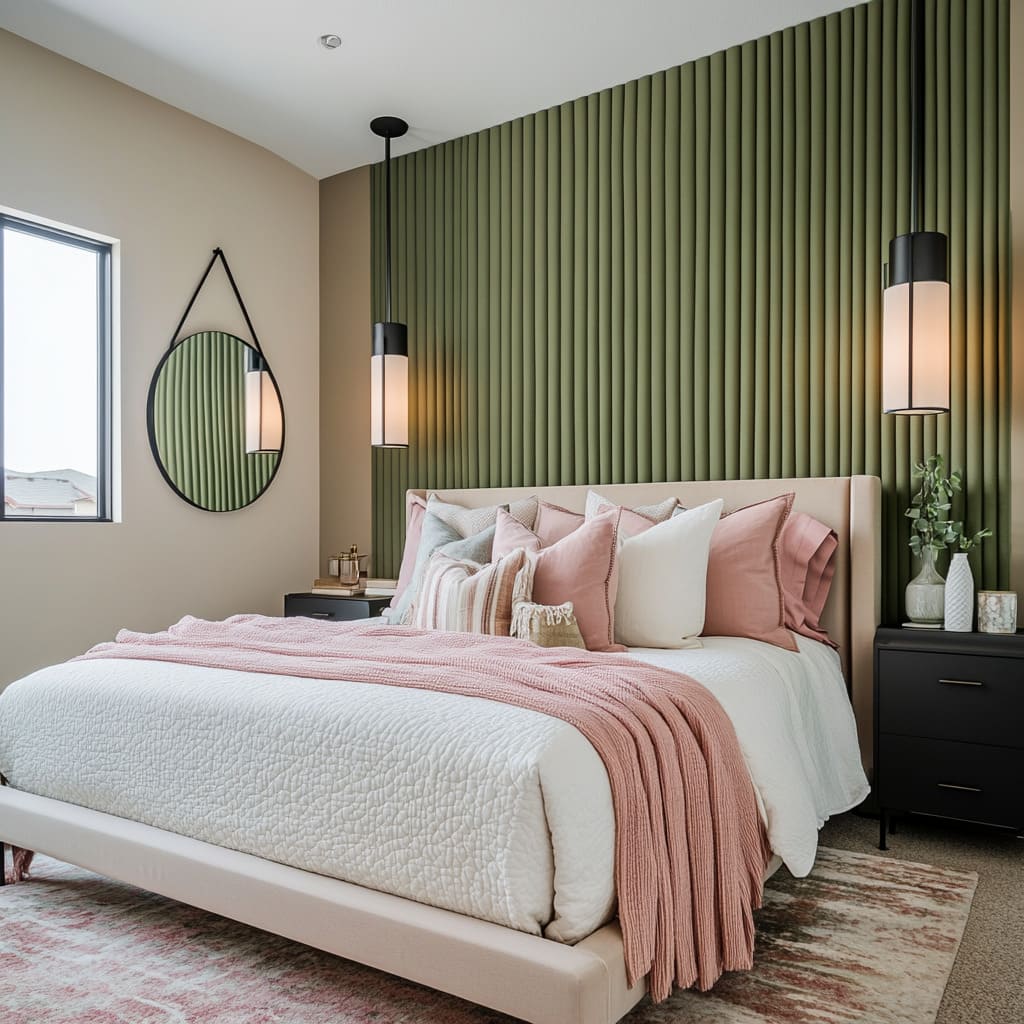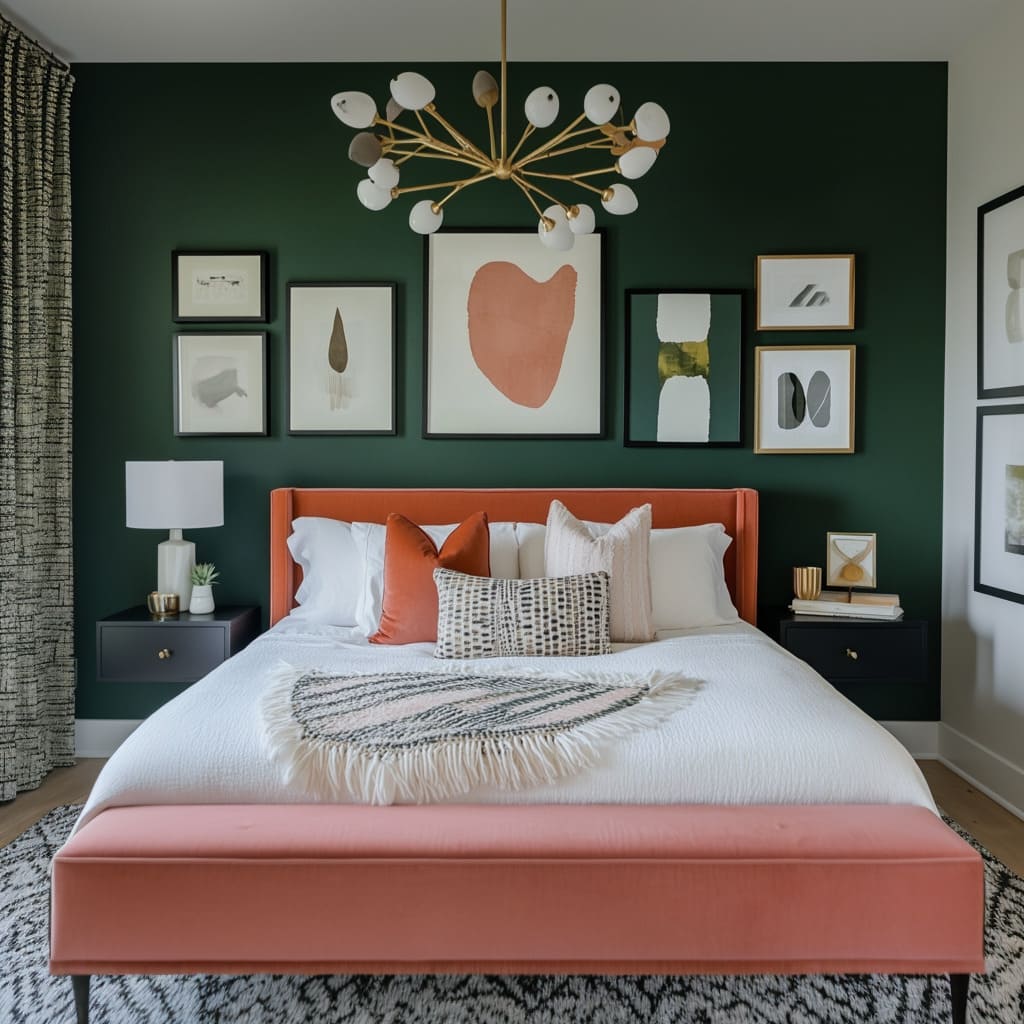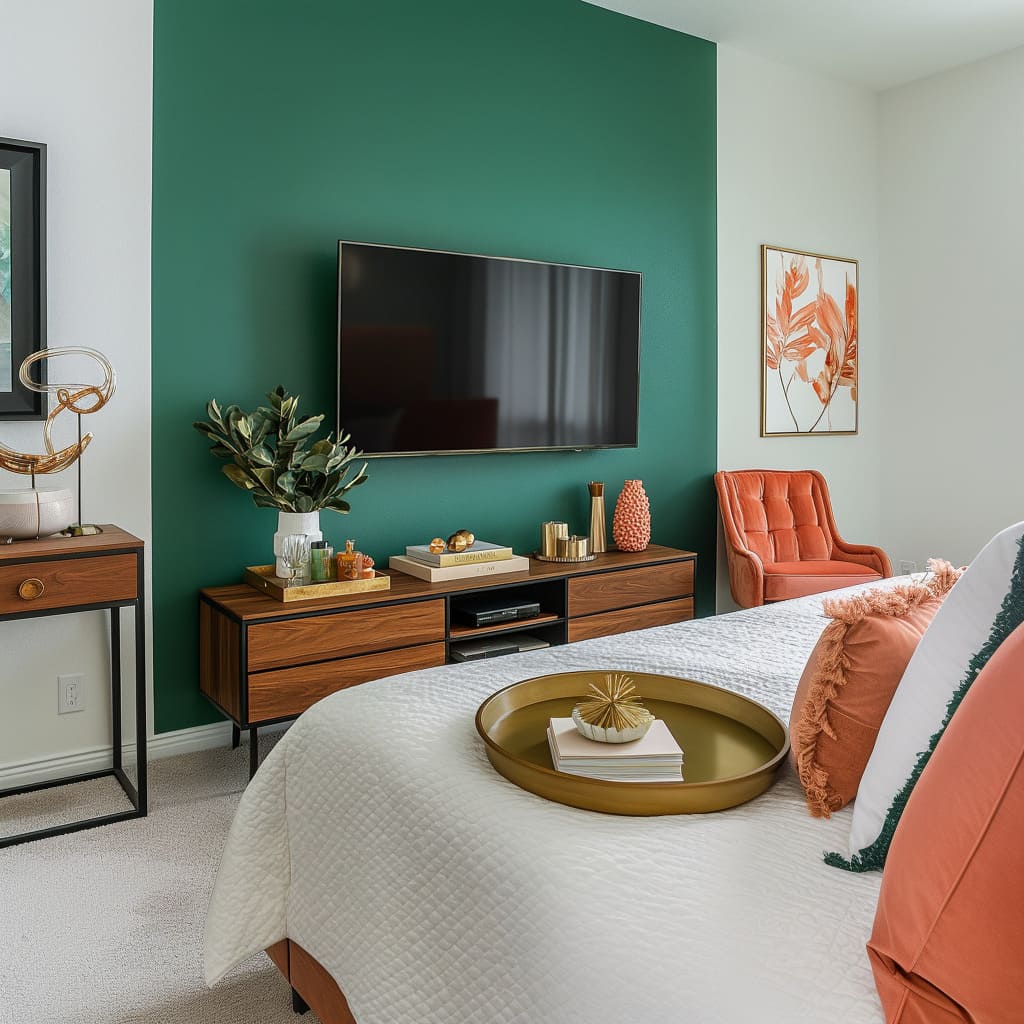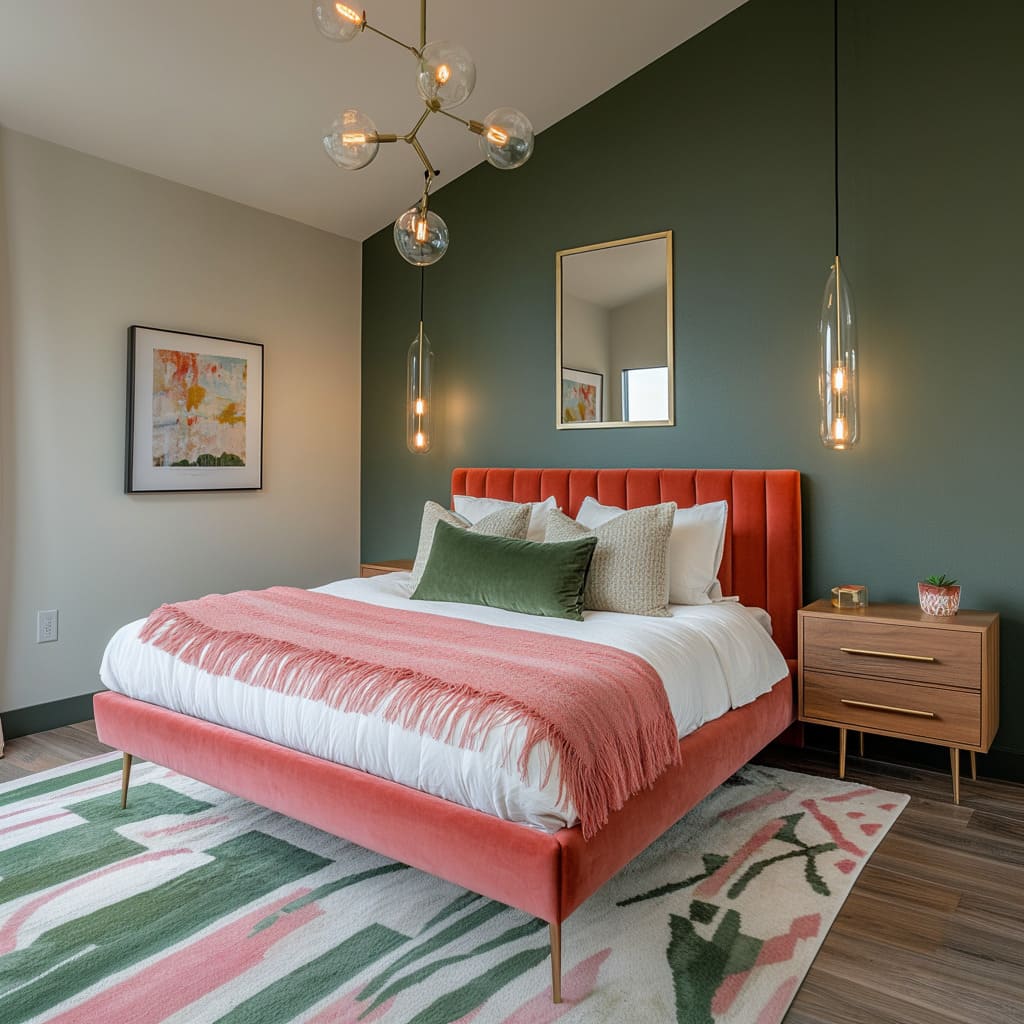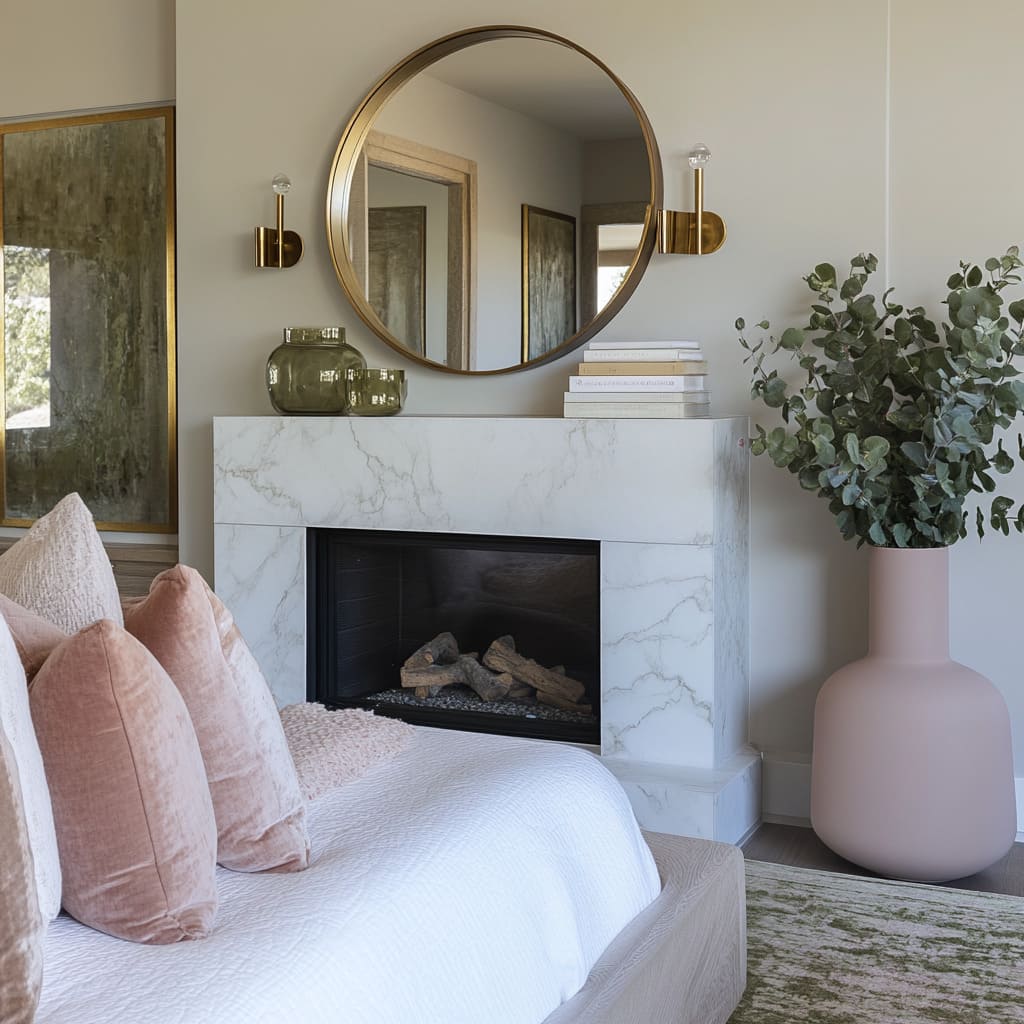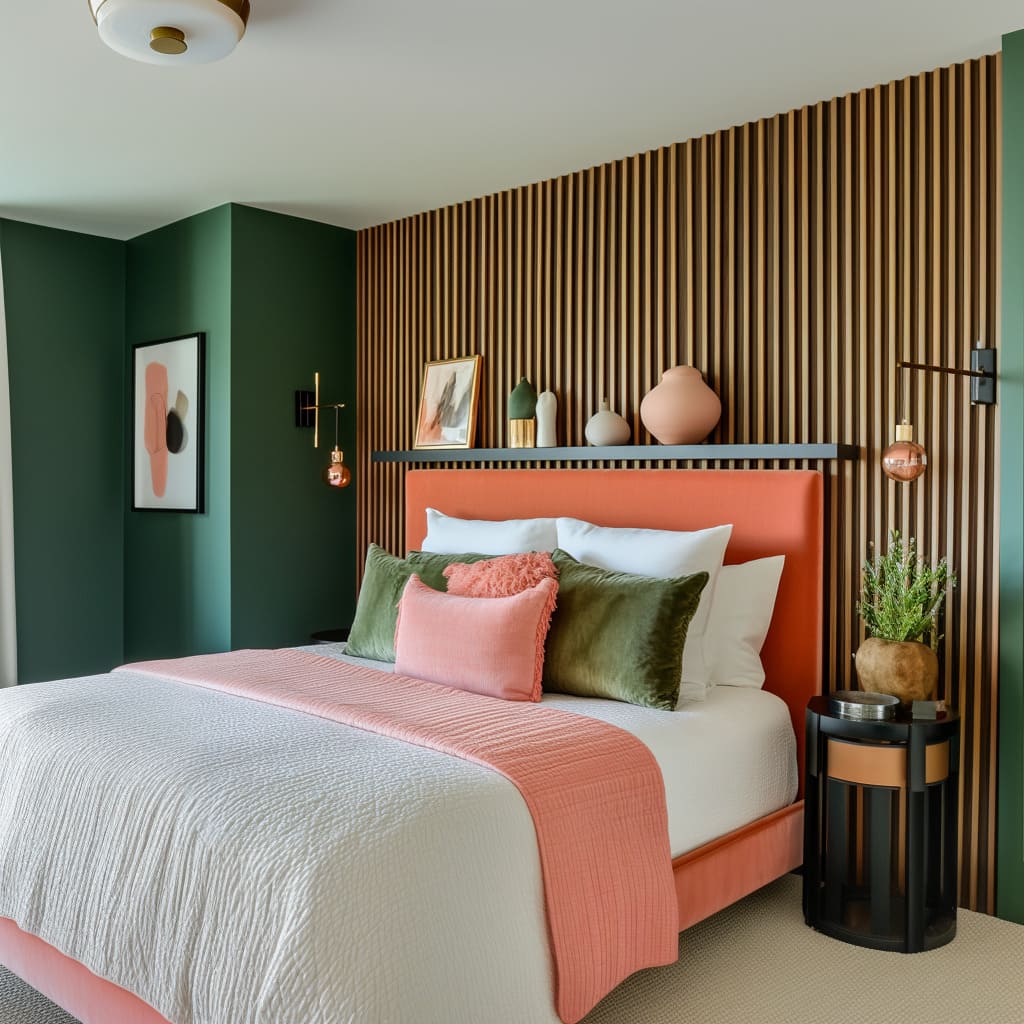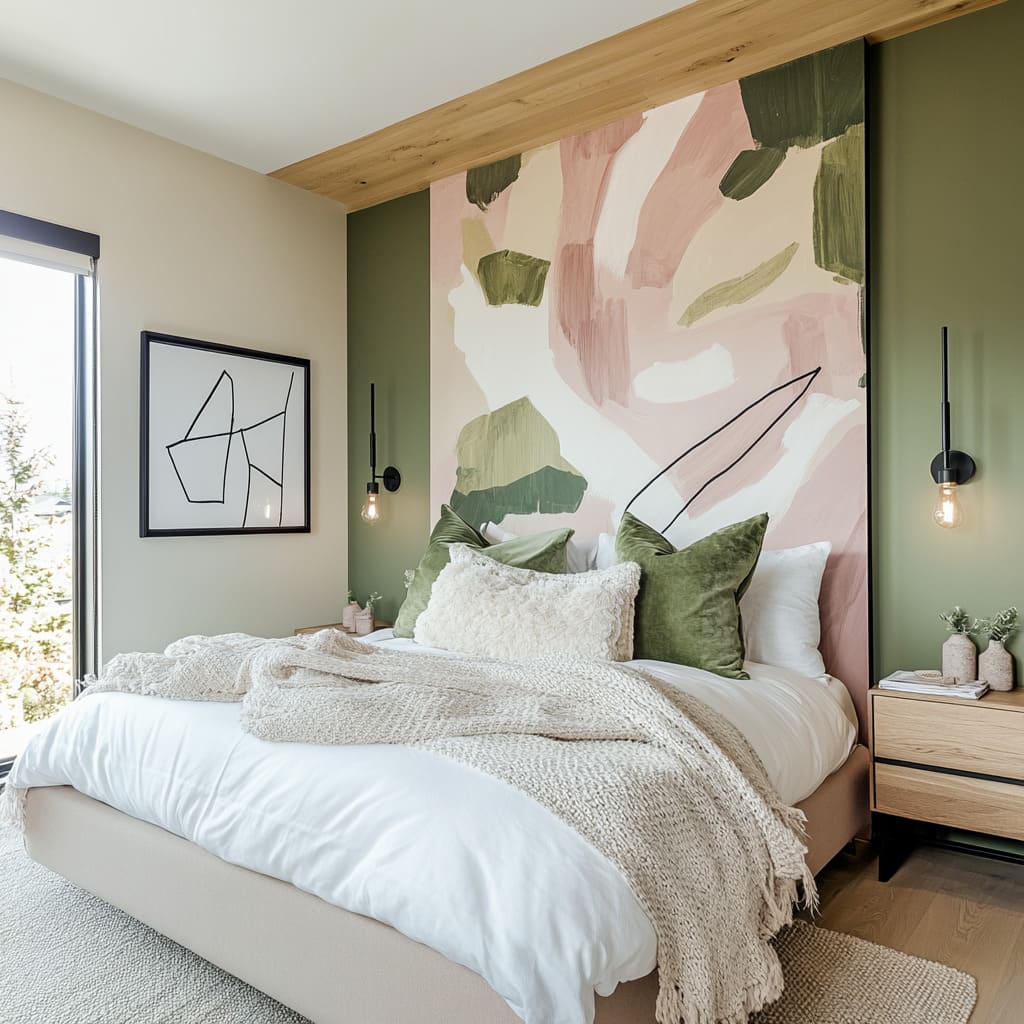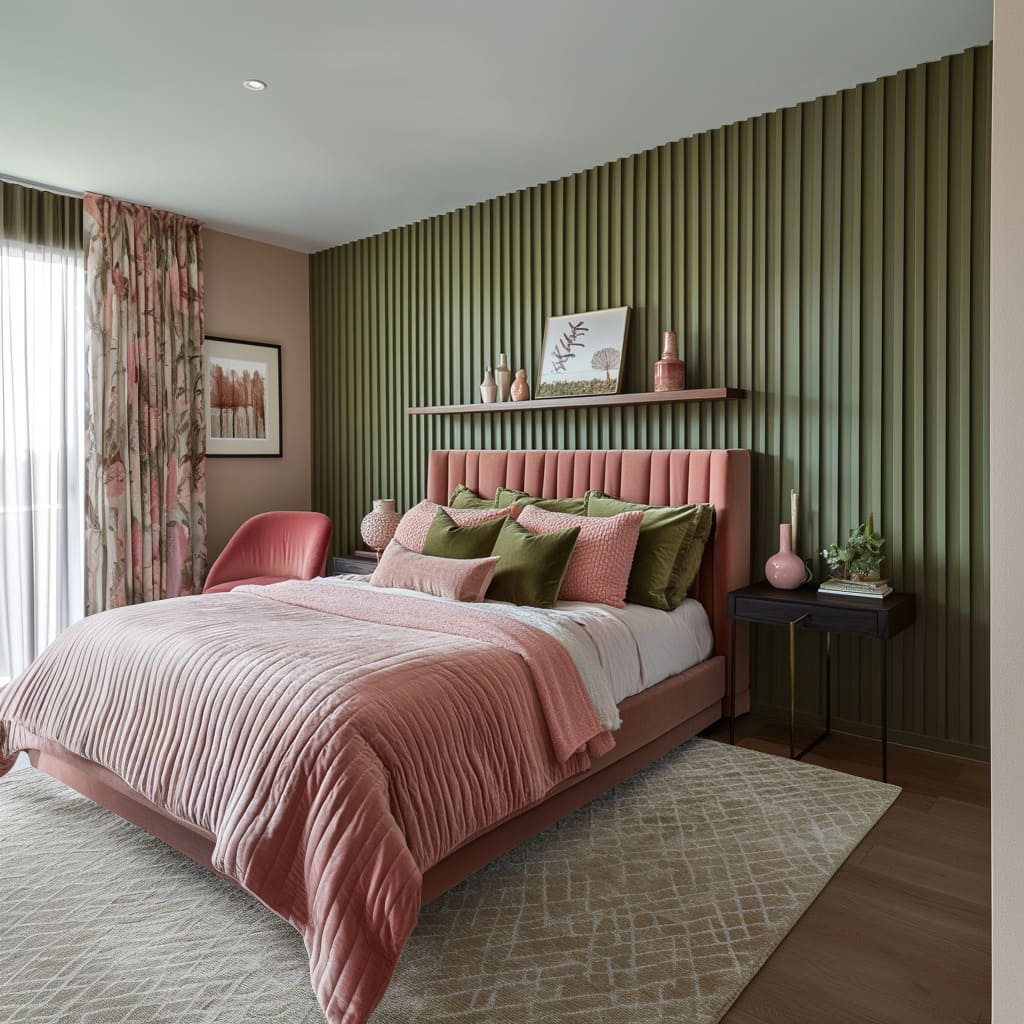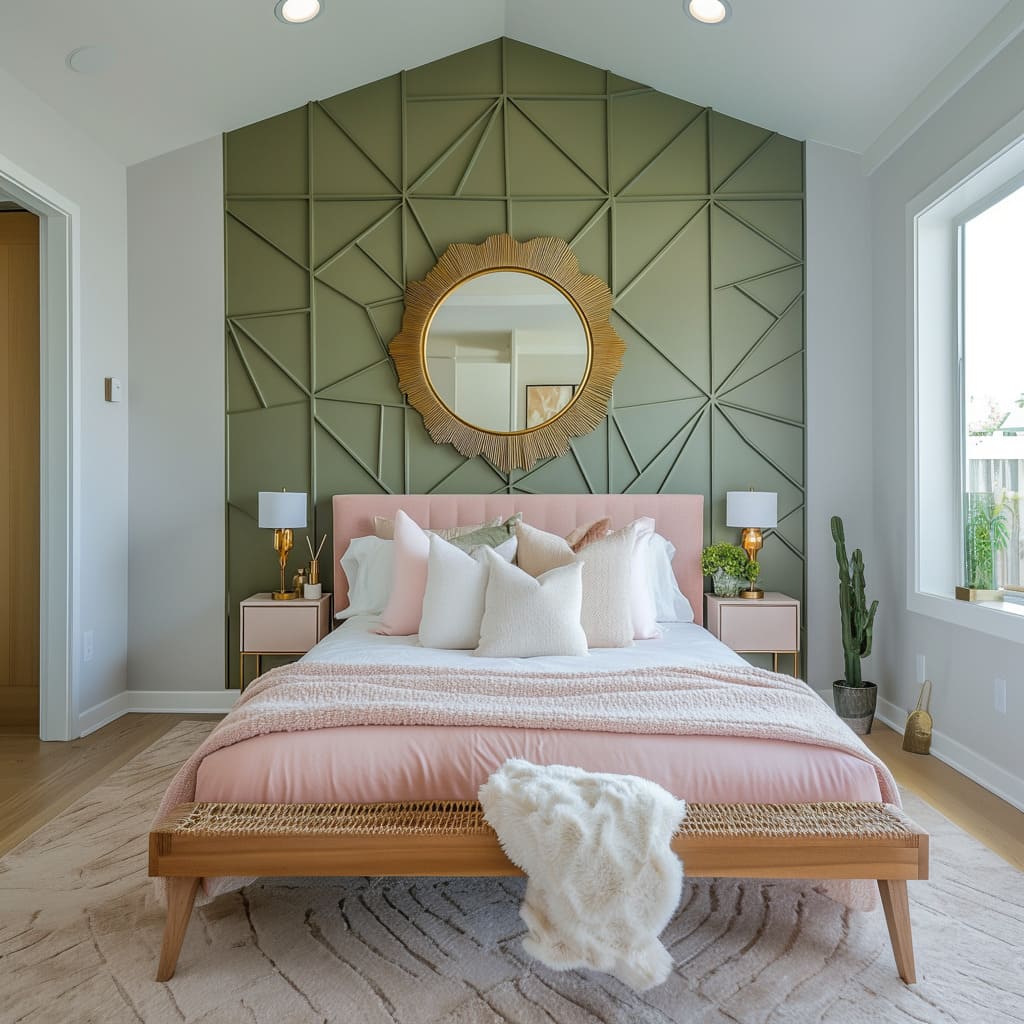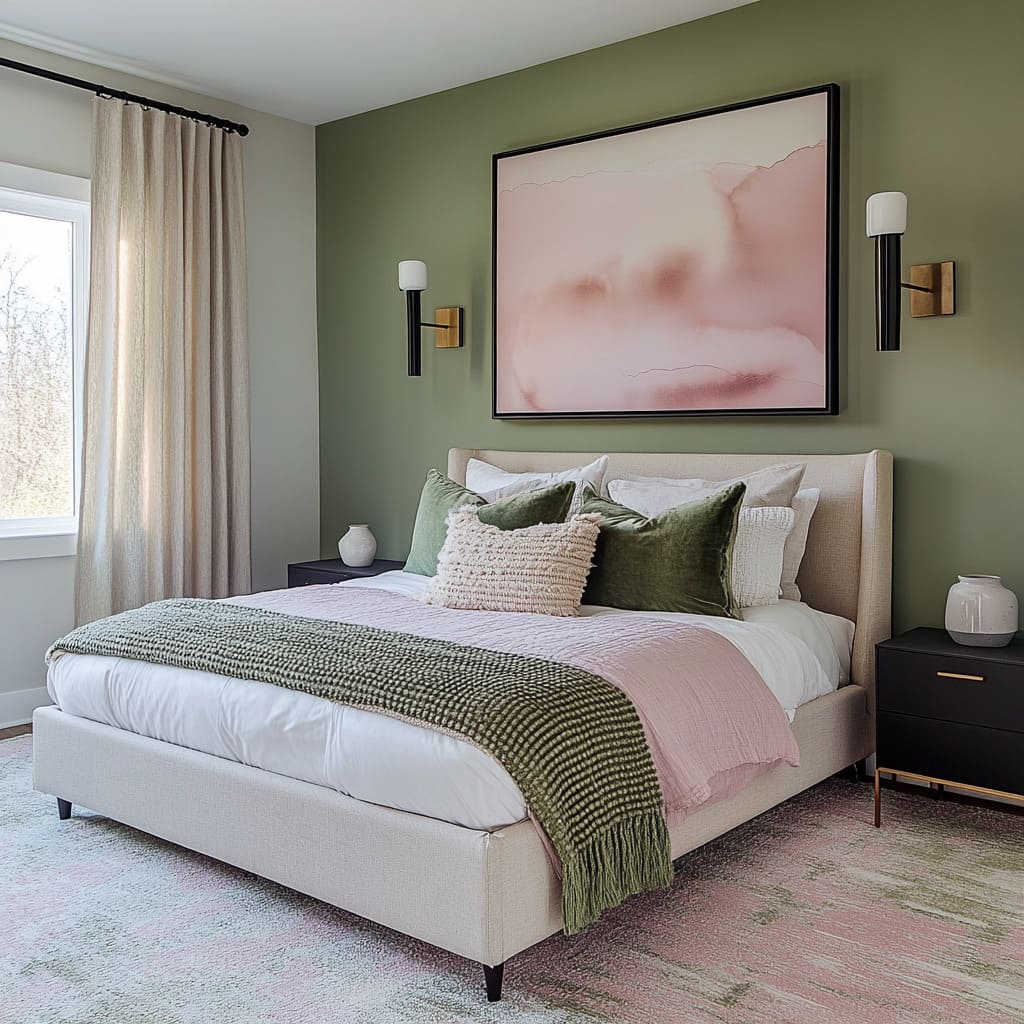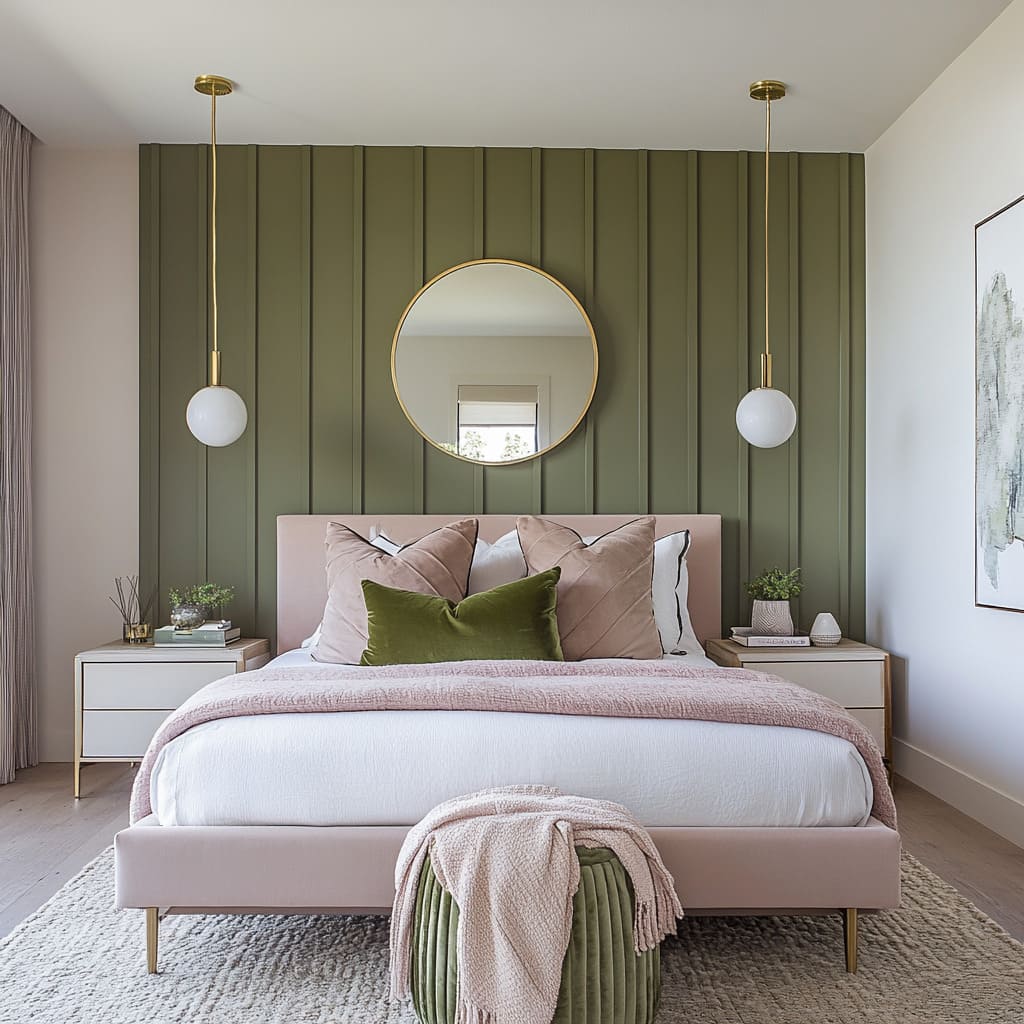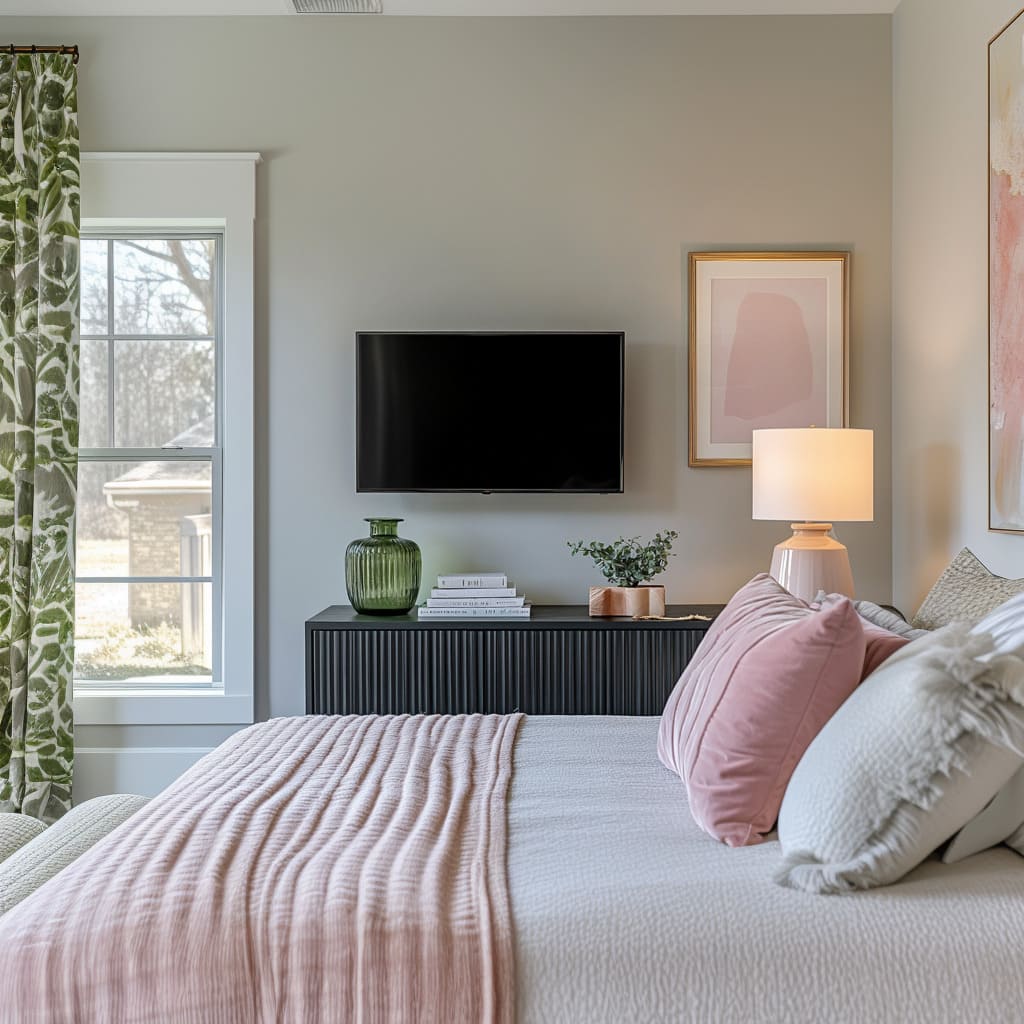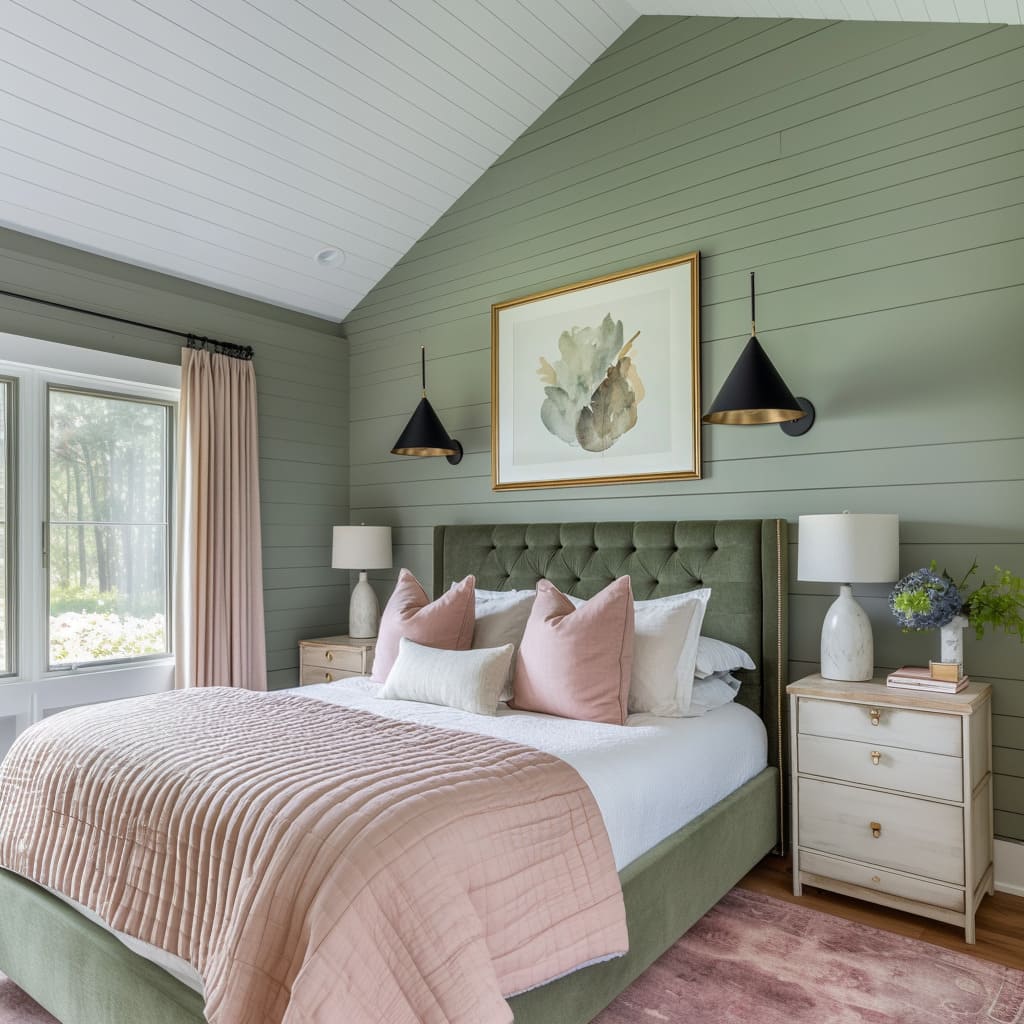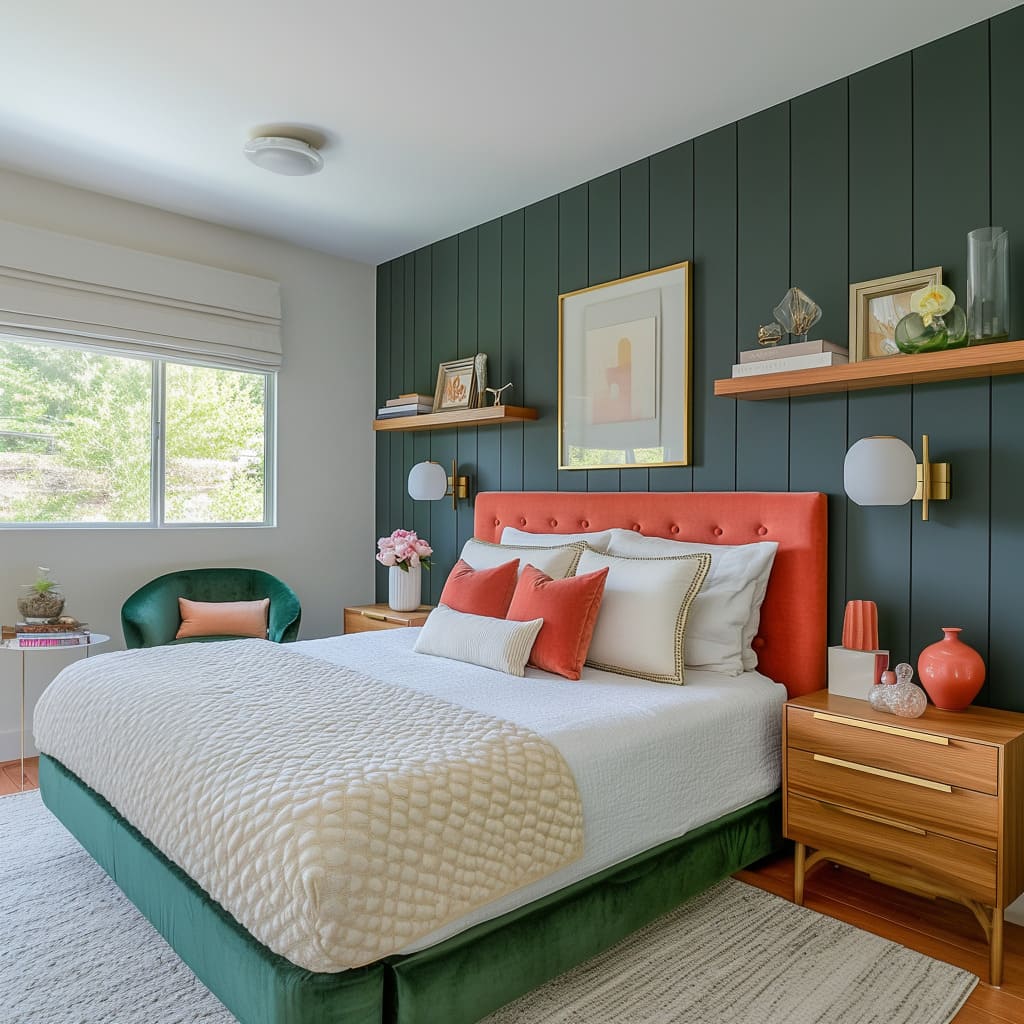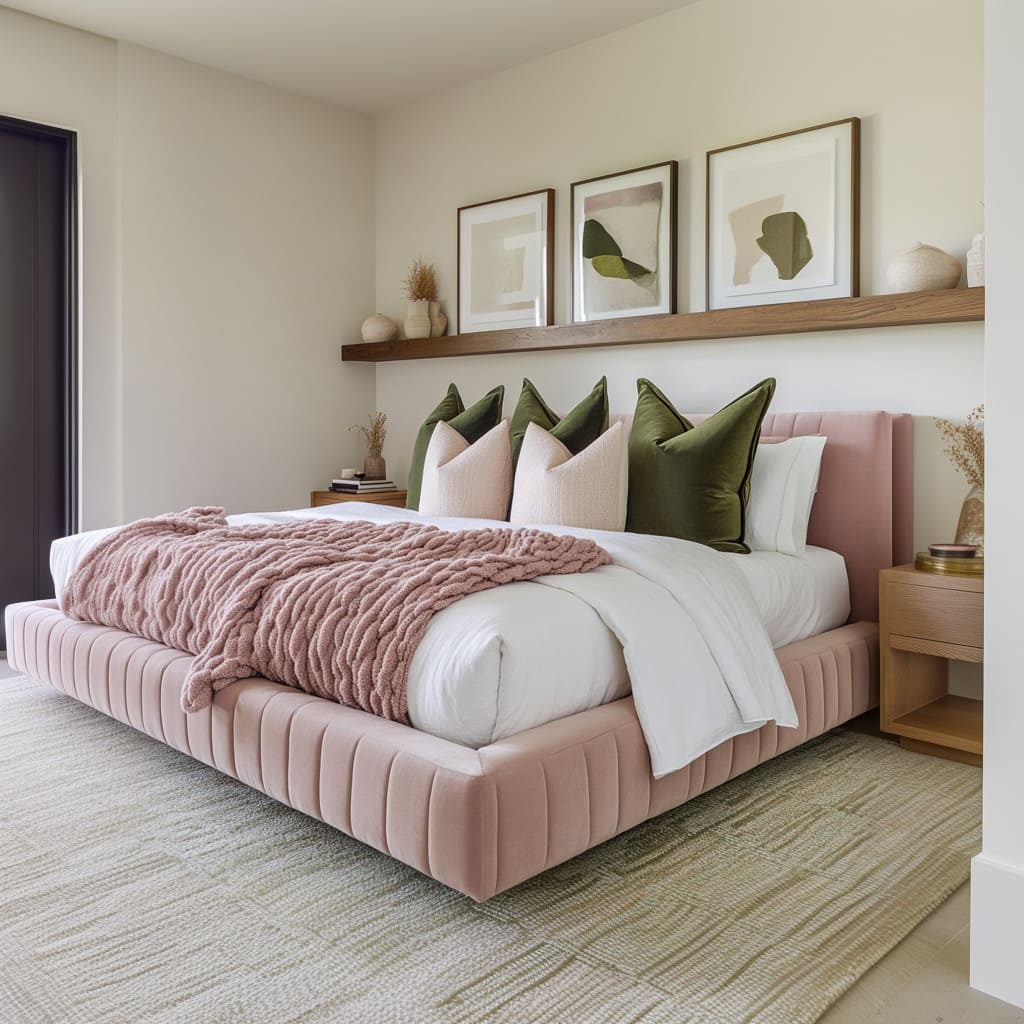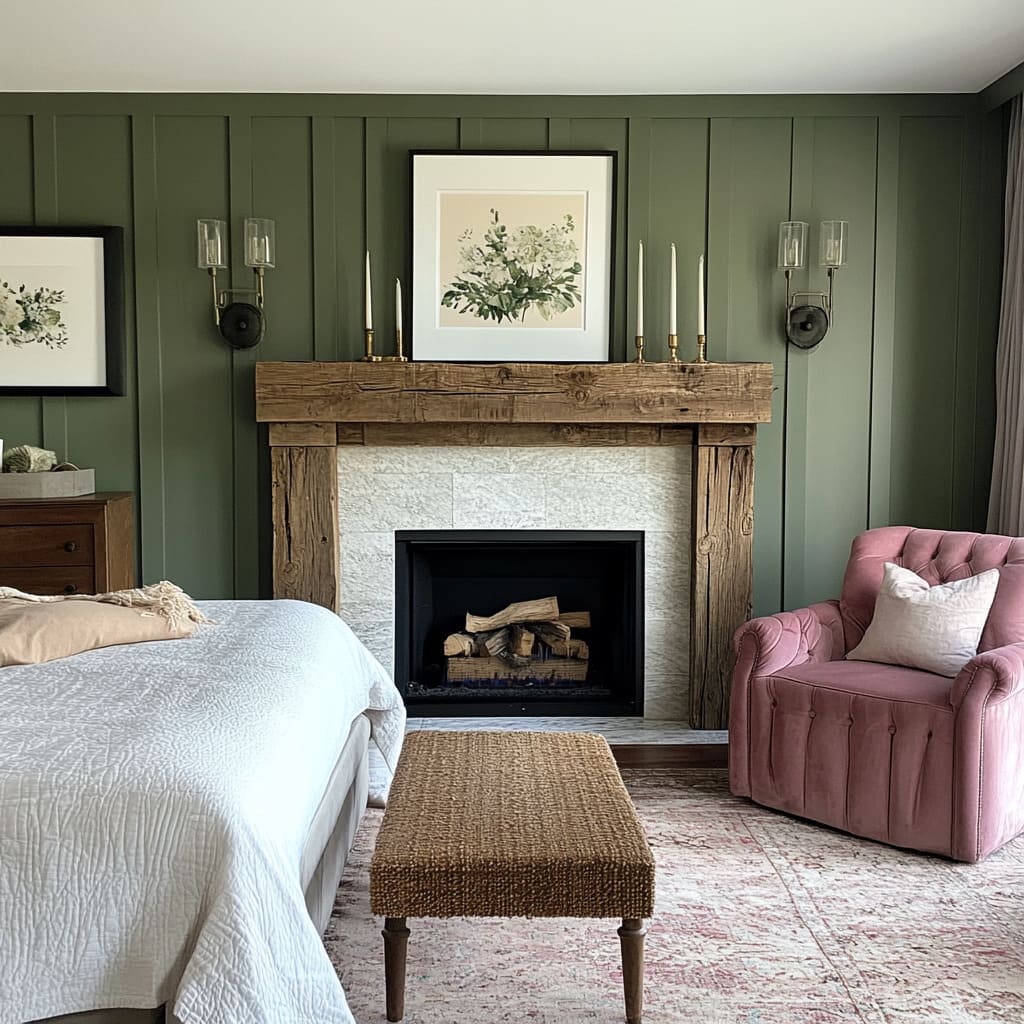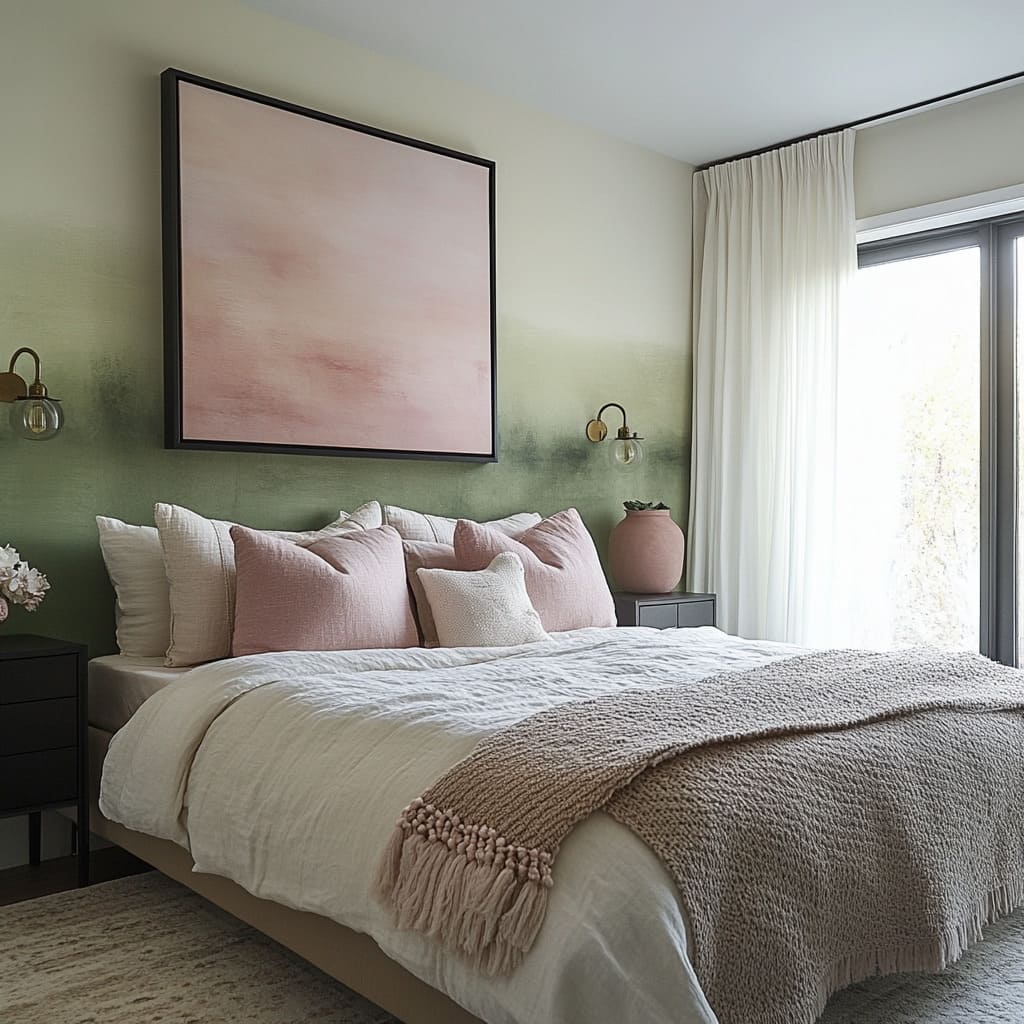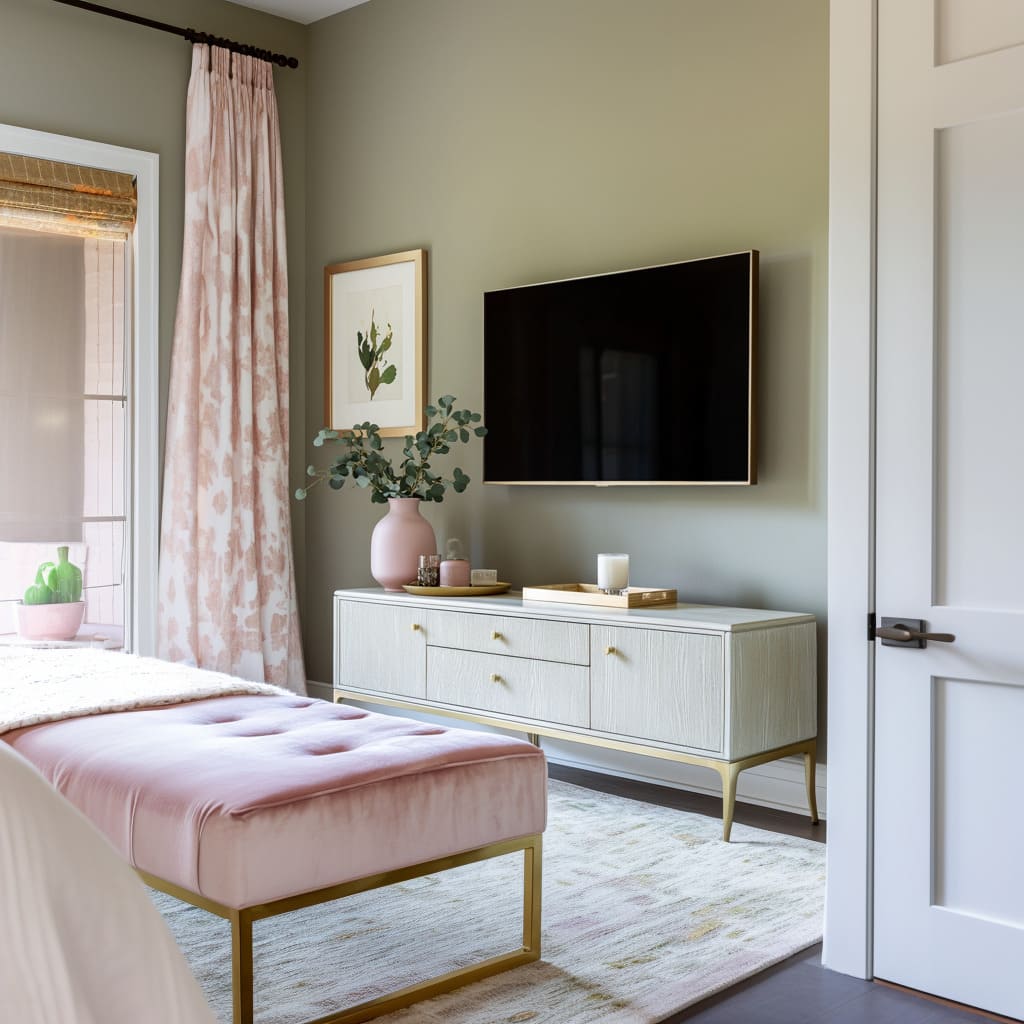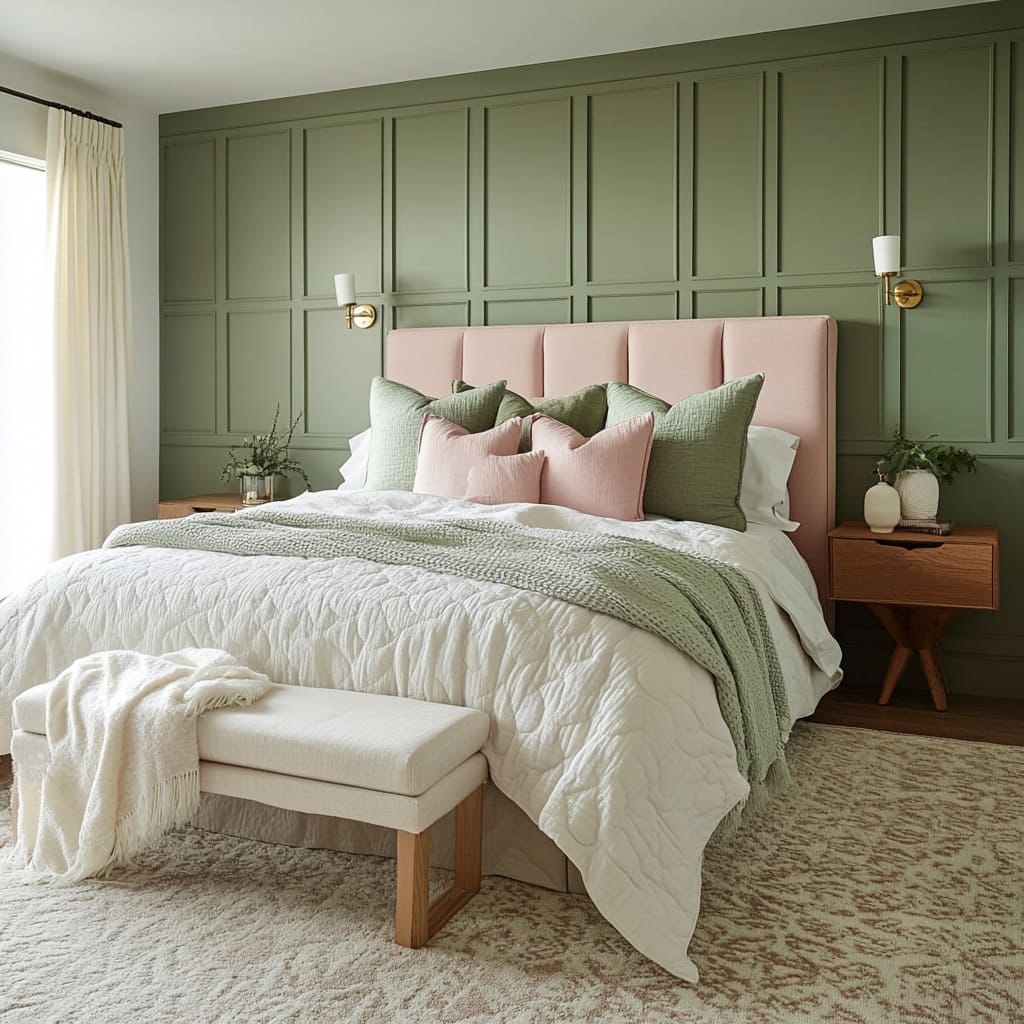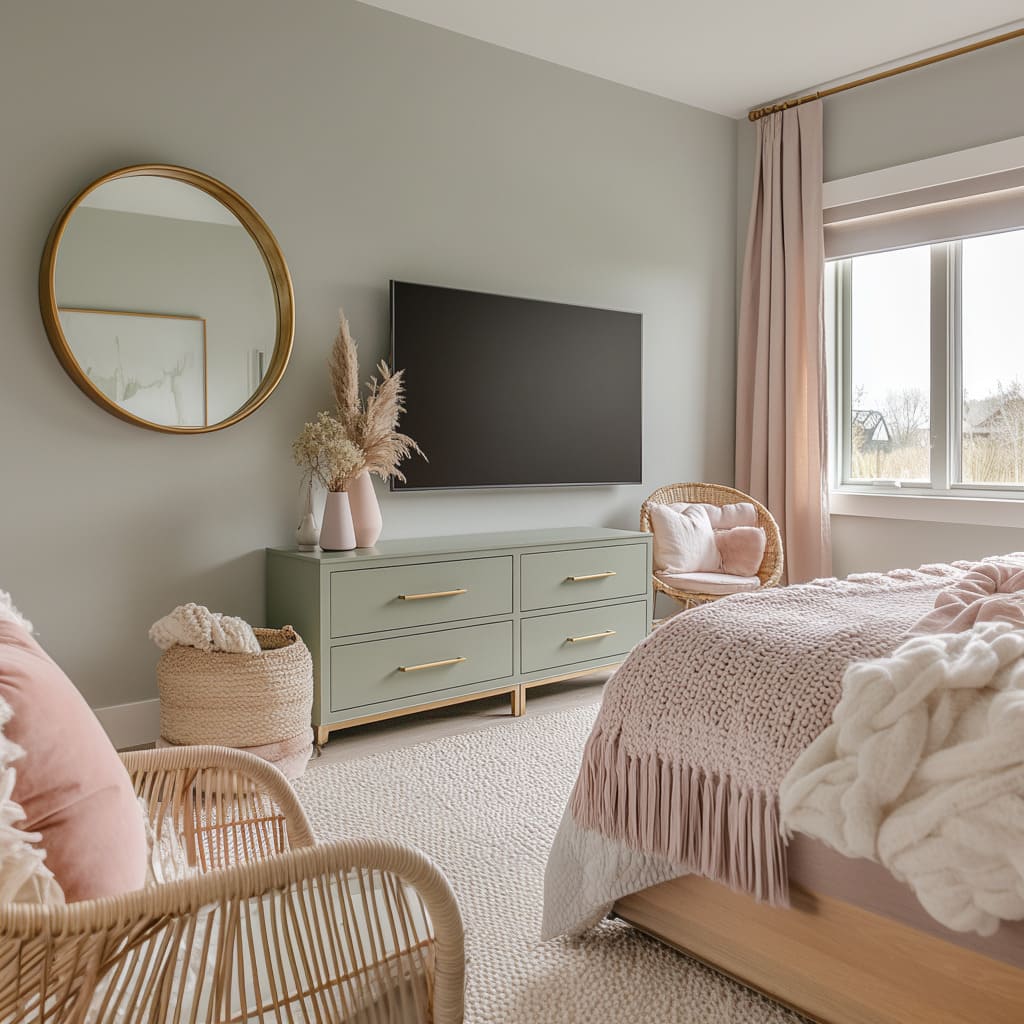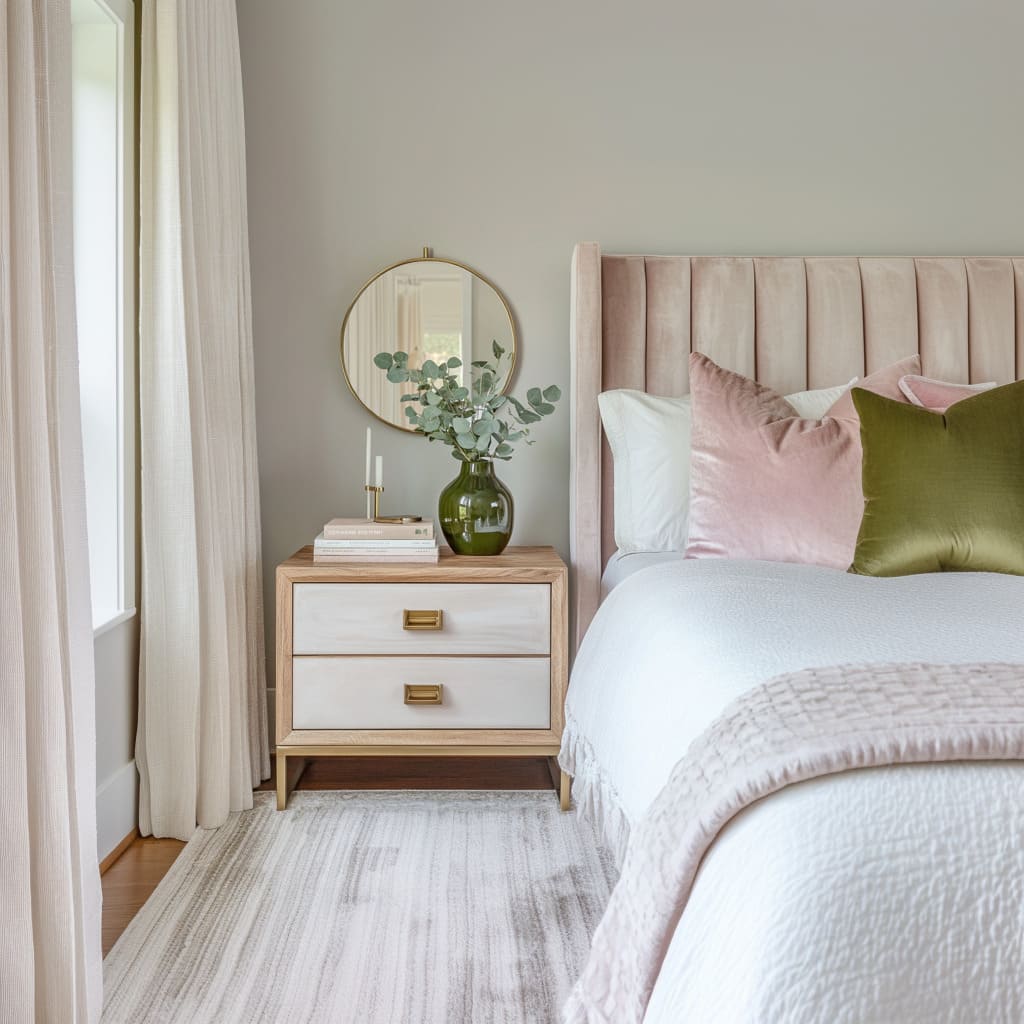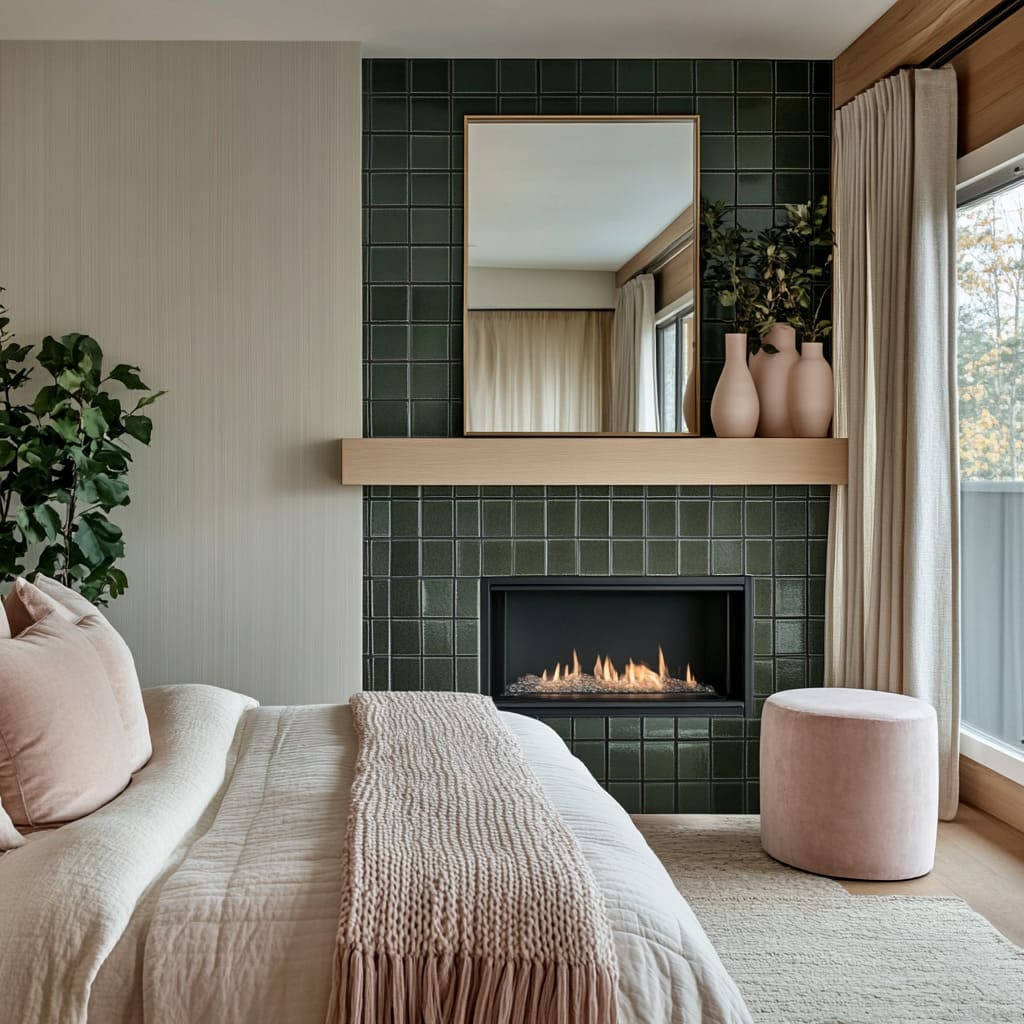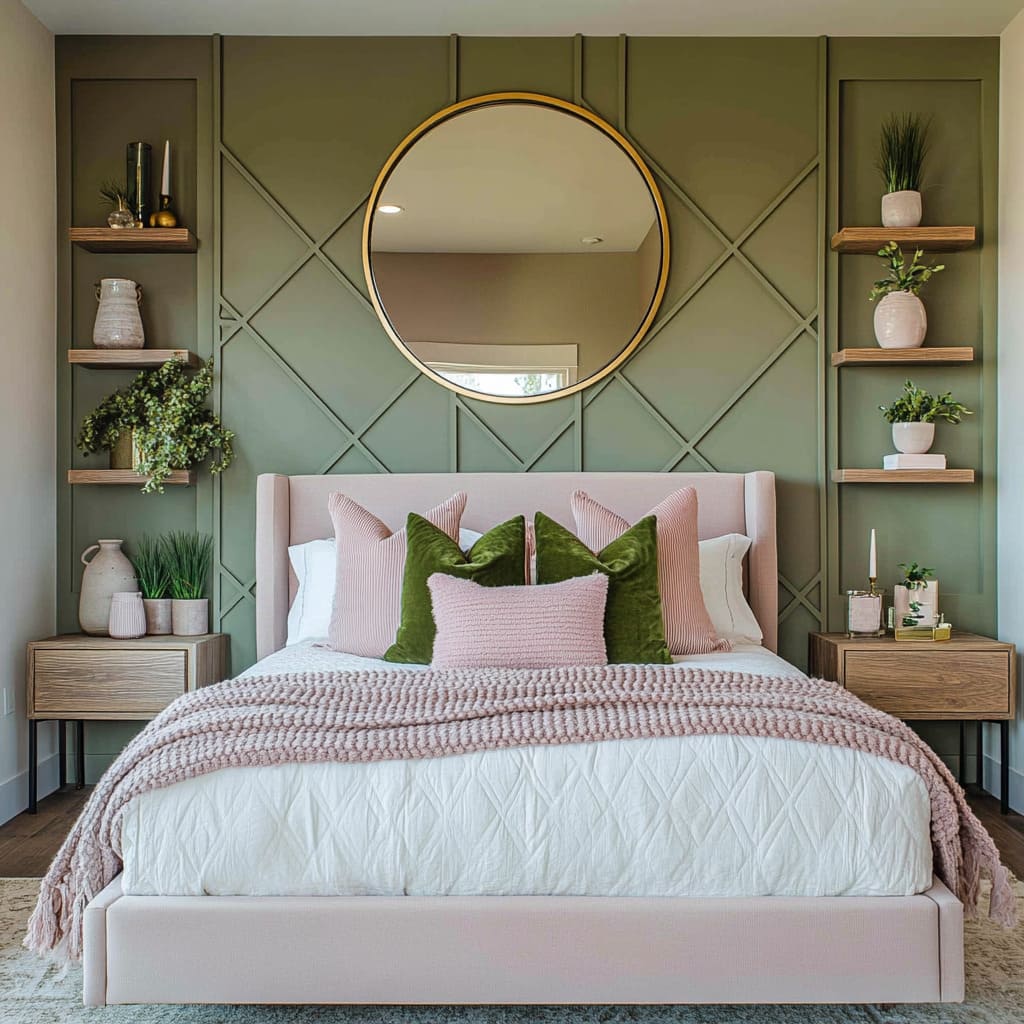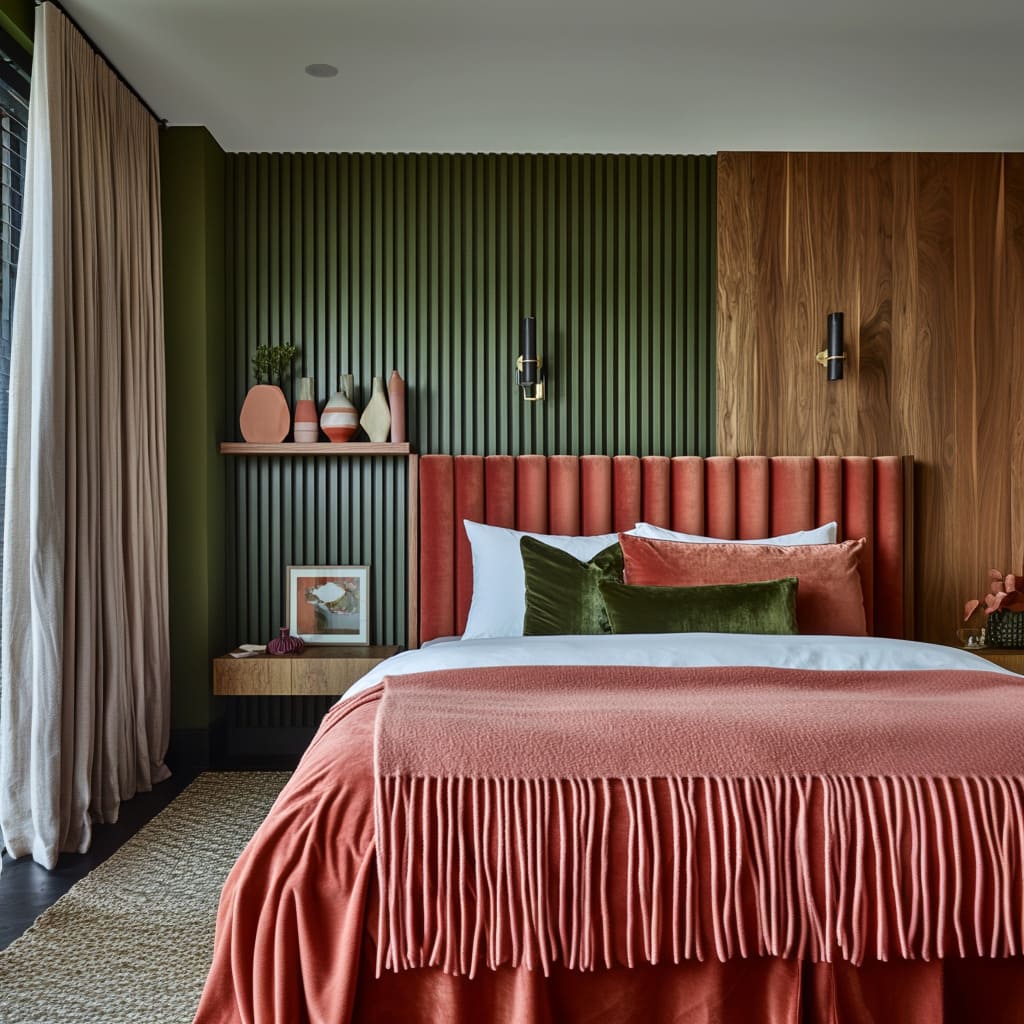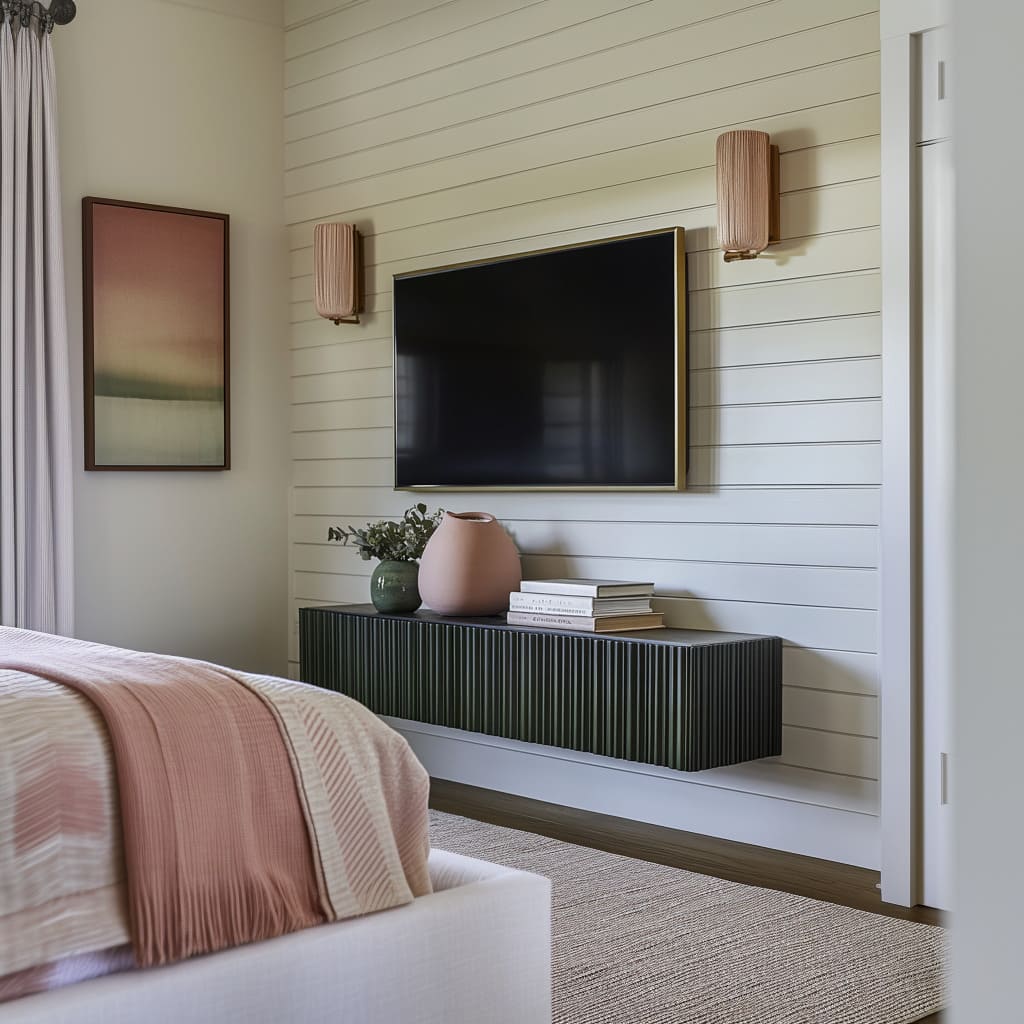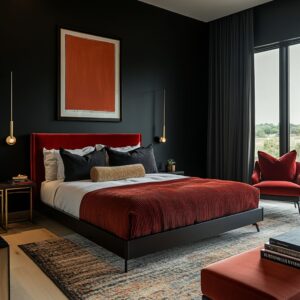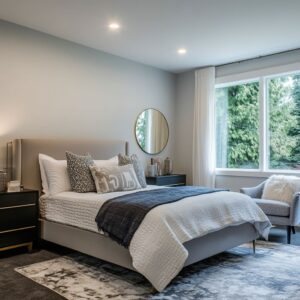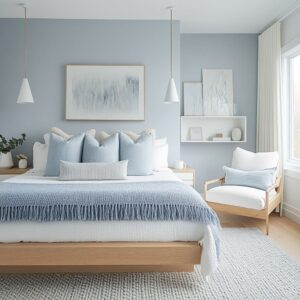Choosing a color scheme is one thing, but creating a bedroom that feels cohesive, stylish, and full of personality is another. This article takes a detailed approach to pink and green bedroom ideas, going beyond simple color coordination.
Instead of just pairing shades, we’ll explore how textures, materials, lighting, and small design choices can bring depth to the space. From classic combinations like blush and sage to bolder contrasts with deep forest green, the right balance can shape the mood of the room.
Beyond color, elements like natural wood, layered textiles, and thoughtful décor placement can create a more inviting and polished look. Whether it’s a minimalist setup with soft pastels or a dramatic space with rich jewel tones, every approach offers a unique way to make a statement.
This guide goes deeper than standard design tips, highlighting both the obvious and the unexpected. It pulls inspiration from different styles and regions, making it easier to adapt these ideas to various aesthetics.
Whether you’re refining an existing bedroom or starting from scratch, these insights will help create a space that feels intentional, balanced, and visually engaging.
Layering Neutrals to Balance Pink and Green
Creating the right balance in a green and pink bedroom isn’t only about choosing the perfect shades—what goes in between plays just as big of a role. That’s where neutrals come in.
Soft beiges, warm taupes, and off-whites act as a bridge, preventing the two main colors from competing and making the space feel more harmonious.
Subtle Tones as a Bridge
One of the easiest ways to introduce neutrals is through fabrics and decorative elements that sit between the stronger hues. A beige knit throw casually draped over a pink duvet or a set of taupe curtains framing a green accent wall can make everything feel connected.
Even small details, like a linen lampshade or an upholstered bench in soft cream, can help soften the contrast without taking attention away from the main color scheme.
Texture Variations
Bringing in texture through neutral materials is just as important as picking the right shade. A woven rattan chair, a thick off-white area rug, or a set of natural wood nightstands keeps the design from feeling flat.
These elements introduce depth, helping the pink and green accents pop without overwhelming the space. Crocheted throws, fringed cushions, and soft boucle fabrics work particularly well, adding a layer of coziness that makes the room feel more inviting.
By layering neutrals in thoughtful ways, the balance between green and pink stays visually pleasing while allowing both colors to shine in their own way. The result is a space that feels carefully put together, with a natural flow that makes the contrast feel intentional rather than abrupt.
Thoughtful Use of Wood and Other Organic Elements
A well-balanced pink green bedroom isn’t just about color—it’s also about the materials that bring warmth and character to the space. Wood and natural elements play a huge role in shaping the overall feel, adding depth while keeping the design cohesive.
Wood Types for Different Moods
The choice of wood can change the entire atmosphere of a room. Darker varieties like walnut and mahogany create a rich, dramatic effect, pairing effortlessly with deep olive walls and muted pink upholstery.
These woods work well in traditional, vintage-inspired, or modern spaces that lean toward bold contrasts. For a softer, more open feel, lighter woods like oak, ash, or raw pine complement pastel pinks and sage greens beautifully.
Their natural grain adds an organic quality that keeps the room feeling relaxed and inviting. A Scandinavian-style space, for example, often blends pale wood flooring with soft pink bedding and green-painted walls for an airy, modern look.
Blending with Stone or Brick
Natural materials like stone or exposed brick can make a pink green bedroom feel layered and grounded. If the walls are painted in olive or deep green, adding a light stone fireplace or brick accent creates a striking contrast that feels organic rather than overpowering.
In a softer color scheme, like blush pink with sage green, incorporating textured stone elements—such as a marble nightstand or travertine décor—can introduce subtle depth without disrupting the flow. These elements also work well in spaces inspired by farmhouse, industrial, or Mediterranean interiors, where natural materials play a key role in balancing color and texture.
By mixing wood, stone, and other earthy finishes, a pink and green bedroom can feel effortlessly stylish and timeless rather than overly coordinated.
Strategic Metal Details
The right metal finishes can bring depth and contrast to a pink and green room ideas setup, adding character without overwhelming the color scheme. Whether it’s the warmth of brass or the boldness of black accents, incorporating metallic elements in a thoughtful way enhances the balance of soft and bold tones in the space.
Brass and Gold
Brass and gold accents naturally complement both pink and green tones, making them a versatile choice for lighting, hardware, and decor. A brass-framed mirror above a deep green wall reflects light in a way that softens the overall look, while gold sconces or table lamps add a subtle glow that enhances blush pink textiles.
Small details—like gold drawer handles, picture frames, or a decorative tray—can tie everything together without making the space feel overly matched. For a more vintage or European-inspired look, consider incorporating aged or brushed brass finishes.
These work especially well in bedrooms with muted sage or olive walls and soft pink linens, bringing warmth and a slightly aged charm that blends seamlessly with natural wood tones.
Black and Bronze
For those looking to add more contrast, black or bronze details create a striking balance against pink and green. A set of black wall sconces mounted on a sage or forest green backdrop instantly makes the space feel more modern, while a dark-framed bed or nightstand keeps the design grounded.
Matte black metal can also be introduced through curtain rods, picture frames, or bedside table lamps, adding definition without overpowering the soft color palette. Bronze is another strong choice, offering a slightly warmer alternative to black that still adds depth.
In rooms with mid-century influences, a mix of dark metal with warm wood finishes can highlight both vintage and contemporary elements, making the space feel layered and well-styled. By carefully selecting metallic details, a pink and green bedroom can feel more polished, with just the right amount of contrast to keep it visually interesting.
Uncommon Accent Pieces that Merge Color Palettes
Creating a space that feels natural and cohesive isn’t always about large furniture or statement walls. Small details can have just as much impact, especially when they subtly bring together the main colors.
Adding decor that blends both shades can make a green and pink decorating ideas setup feel more intentional without overpowering the room.
Greenery and Florals
One of the easiest ways to merge pink and green in a room is through plants and floral arrangements. Whether real or faux, greenery naturally echoes green wall tones, while flowers in soft blush hues introduce a delicate balance.
A vase filled with eucalyptus branches paired with muted pink roses or dried pampas grass can reinforce the color scheme without needing extra furniture. For a modern touch, terracotta or sage-colored planters with sculptural greenery—such as snake plants or olive trees—can introduce depth without adding clutter.
In a softer setting, a bouquet of blush-toned hydrangeas on a nightstand or a sprig of dried flowers on a bookshelf brings in just enough color to make an impact.
Art and Sculptural Forms
Wall art and decorative pieces offer another way to subtly blend pink and green tones. A large canvas featuring abstract shapes in muted blush and sage hues can create a natural connection between the two colors.
For a more understated approach, framed botanical prints with soft pink flowers against green backgrounds can add depth without making the space feel too themed. Sculptural decor is another option that often gets overlooked.
A ceramic vase in dusty rose or sage placed on a wooden console, a softly textured sculpture in a neutral tone, or even a woven basket with subtle green fibers can tie together different parts of the room. Even functional items—like books with green and pink covers stacked on a nightstand—can serve as quiet but effective accents.
By layering these smaller details, a pink and green bedroom can feel effortlessly cohesive, allowing the colors to blend in a way that feels natural rather than overly styled.
Using Pattern and Print in Moderation
Adding patterns to a bedroom can enhance the design, but the key is knowing when to stop. Too much can feel chaotic, while too little might leave the space looking flat.
The right balance makes a pink and green bedroom ideas for adults setup feel intentional and refined.
Botanical or Geometric Prints
Patterns are a great way to bridge the color scheme without overwhelming the space. Botanical prints, for example, naturally connect pink and green by incorporating floral elements in soft, organic shapes.
A set of curtains with a delicate leaf pattern or an area rug that weaves in both colors can subtly reinforce the theme without feeling overpowering. Geometric prints offer a more structured alternative.
A throw pillow with a simple, repeating pattern in blush and sage can add just enough contrast to keep things interesting. Stripes, chevron designs, or even minimalist linework in the right shades can make the room feel more polished while keeping the overall look cohesive.
Refined Repetition
One of the best ways to incorporate patterns without overloading the space is through subtle repetition. A leaf print on a decorative pillow can echo a similar design on a framed artwork above the bed.
A textured duvet with small, embroidered details can complement a patterned lampshade without clashing. For those who prefer a more minimal look, using patterns in a single area—such as a statement wallpaper behind the bed—can be enough to add character while keeping the rest of the space simple.
By repeating small design elements thoughtfully, the bedroom remains stylish and visually connected without feeling cluttered.
Fireplaces and Architectural Highlights as Backdrops
A well-placed fireplace or architectural feature can be more than just a functional element—it can become the visual anchor of a pink and green bedroom. Whether it’s a classic mantelpiece or a textured accent wall, these details help frame the space and bring a sense of structure to the design.
Layered Mantels
A fireplace mantel provides the perfect surface for adding depth and tying together the room’s color scheme. Placing pink and green ceramic vases of varying heights alongside framed artwork with soft, blended tones keeps the setup feeling intentional without looking cluttered.
A symmetrical arrangement—such as matching candleholders or a pair of sconces flanking a central mirror—can enhance the architectural presence while maintaining a clean look. For a more casual and layered effect, leaning artwork against the wall instead of hanging it creates a relaxed feel.
Mixing different textures, like matte ceramic, glass, and woven elements, adds variety while keeping the color palette consistent.
Paneled or Tiled Accent Walls
A bold architectural detail like a green paneled or tiled wall can define the space without needing excessive decor. To balance its presence, introducing pink in subtle yet deliberate ways—such as a blush-toned ottoman, a soft throw blanket, or decorative pillows—keeps the color contrast from feeling too stark.
Paneled walls, especially those in deep green shades, add depth and structure, making them an ideal backdrop for a bed with pink upholstery or layered linens in warm neutral tones. Textured tile or stone in a green hue can also bring in an organic touch, especially when paired with soft pink accessories that provide contrast without overwhelming the space.
By treating architectural features as part of the overall design rather than just functional elements, the bedroom gains a more polished and cohesive feel. Whether through decorative layers on a mantel or the careful balance of color against a statement wall, these elements add character while supporting the overall theme.
Balanced Lighting Choices
Lighting does more than just brighten a space—it shapes the atmosphere and enhances the way colors interact. In a pink and green bedroom, the right fixtures can highlight textures, create depth, and bring a sense of balance between the two contrasting tones.
A thoughtful mix of overhead, task, and accent lighting makes the space feel intentional at any time of day.
Pendant and Sconce Placement
Symmetry is a subtle but effective way to unify a pink-and-green color scheme. Hanging pendant lights or installing sconces on both sides of a pink headboard set against a green accent wall creates a structured look that ties the space together.
The repetition of lighting elements helps blend the two colors, preventing either from feeling too dominant. Choosing the right finish also makes a difference—brass or gold sconces bring warmth to muted shades, while matte black or bronze fixtures create a striking contrast, especially in modern interiors.
For a softer touch, frosted glass shades diffuse the light, keeping the colors looking rich without harsh reflections.
Layered Lighting for Depth
Relying on a single light source can make a room feel flat, especially when working with two strong colors. A combination of different fixtures at varying heights helps highlight textures and softens the contrast between pink and green.
A statement chandelier or ceiling fixture provides general illumination, while bedside lamps and wall-mounted sconces offer more focused lighting. If the room has architectural details like a paneled green wall or a textured pink throw, strategic lighting can make those elements stand out.
For a cozy ambiance, dimmable bulbs allow the room to transition from bright and airy during the day to soft and inviting in the evening. By layering different types of lighting, the bedroom gains a sense of depth and dimension, ensuring that both colors are well-balanced and visually appealing at all times.
Contrasts in Furniture Shapes
A well-designed pink and green room isn’t just about color choices—furniture shapes play a major role in defining the overall feel. Mixing structured and curved forms adds subtle complexity, keeping the space visually engaging without feeling overly coordinated.
Curvilinear vs Structured
Playing with different silhouettes is an easy way to bring contrast into a bedroom. If the bed has strong, rectangular lines, upholstered in a soft pink fabric, adding rounded green accent chairs or an oval ottoman can introduce balance.
The combination of straight and curved shapes creates a natural flow, making the space feel layered rather than rigid. This approach works especially well when integrating modern and vintage elements.
A sleek, structured dresser in muted green pairs beautifully with a curved pink chaise lounge, softening the overall look while keeping it sophisticated. Similarly, a round mirror above a geometric nightstand can subtly echo this contrast without feeling forced.
Modern-Classic Fusion
Blending different furniture styles can make a bedroom feel more dynamic. A mid-century wooden nightstand, known for its clean lines, gains a fresh update when placed beside a tufted pink headboard.
The green wall or green velvet cushions tie everything together, proving that a mix of eras can look intentional when unified by color. For those who prefer a more contemporary feel, a structured green bed frame with minimalist legs can be softened with plush pink bedding and rounded decorative elements, such as a curved bedside lamp or sculptural ceramic vases.
This careful balance between sharp and soft details makes the space feel curated rather than predictable. By combining contrasting shapes and styles, the room avoids looking overly matched while maintaining a cohesive feel.
The key is to let different forms play off each other, using color as the unifying element.
Small-Scale Decor with Big Impact
Not every design decision needs to be grand to make a difference. Sometimes, the smallest details have the biggest influence, especially when they’re placed with intention.
Thoughtfully arranged decor can bring a pink and green bedroom together without requiring a major overhaul.
Tiny Decor Vignettes
Grouping small decorative pieces in a way that reinforces the color scheme is a simple but effective styling trick. A side table or floating shelf with stacked books, ceramic bowls, and candleholders in pink and green instantly ties the palette together.
This approach works particularly well in spaces where large statements—like an accent wall or oversized furniture—aren’t an option. For a natural flow, layering different textures makes these vignettes feel more organic.
A matte green vase, a glossy pink dish, and a soft linen-wrapped book create subtle contrast while keeping the colors in harmony. Small sculptures, framed artwork, or a single fresh flower in a bud vase can add even more character without overwhelming the space.
Books as Styling Elements
Books aren’t just for reading—they can also be an easy way to reinforce a color scheme. Selecting books with spines in muted pinks and soft sage greens for open shelving or tabletop arrangements keeps everything looking intentional.
Instead of random colors that might clash, this small adjustment blends decor and function seamlessly. For a refined touch, stacking books in alternating shades can add a subtle visual rhythm to the space.
Topping the stack with a candle, a delicate trinket, or a decorative object in a neutral shade can complete the look without making it feel too curated. These understated details may not demand attention on their own, but together, they shape a space that feels thoughtful and cohesive.
With just a few carefully placed accents, a pink and green bedroom can feel polished without the need for dramatic changes.
Personalizing with Unexpected Hues
While pink and green create a striking combination on their own, introducing a third, unexpected hue can add personality and dimension. Thoughtfully selected tones help refine the look, making the space feel curated rather than predictable.
Deep and Dusty Shades
The key to a sophisticated color palette is avoiding overly saturated tones. Instead of bright pink or neon green, muted alternatives—like dusty rose and deep forest green—create a more timeless feel.
These shades bring warmth and richness without overwhelming the space, making them especially effective in bedrooms meant to feel inviting and relaxing. A headboard upholstered in dusty rose pairs effortlessly with dark green walls, while soft-textured accents, such as a woven rug or linen drapes, help blend the tones seamlessly.
Even furniture choices can play a role—choosing a sage-green dresser with brushed brass hardware or a set of pink ceramic lamps with a matte finish reinforces the color scheme while keeping it understated.
Additional Color Highlights
A third color can act as a bridge between pink and green, making the palette feel more dynamic without disrupting its harmony. Warm terracotta, pale mustard, or soft gray can be introduced through accent pillows, artwork, or decorative objects.
A single throw blanket in a golden hue or a hand-painted ceramic vase in a warm earth tone can subtly enhance the space without drawing too much attention. For those who prefer a more artistic approach, a framed abstract print incorporating all three colors—pink, green, and an unexpected accent—can tie everything together while adding a creative touch.
Even the simplest details, like a patterned cushion with a hint of burnt orange or a floral arrangement featuring deep plum tones, can shift the overall aesthetic in an interesting way. By carefully integrating these extra hues, a pink and green bedroom gains more depth and feels uniquely tailored to the person who lives in it.
It’s all about finding the right balance—small doses of unexpected color can elevate the entire look without taking away from the primary palette.
Final Thoughts
A pink and green bedroom can feel both inviting and well-balanced with the right approach. The key is to layer neutrals to soften bold contrasts, introduce varied textures for depth, and carefully select accent pieces that tie everything together.
Wood, metal, and patterned elements play a subtle but essential role in refining the overall look, ensuring the space doesn’t feel overly coordinated or predictable.
Small details make the biggest difference. A ceramic vase in a muted pink that mirrors the tone of an accent pillow, or a geometric print that subtly repeats across different decor pieces, can bring a sense of cohesion without overwhelming the design.
Thoughtful repetition of colors and textures makes the room feel intentional and polished rather than simply color-blocked. By approaching the space with a keen eye for contrast, balance, and subtle layering, it’s easy to create a pink and green bedroom that feels stylish, comfortable, and uniquely personal.
Whether the goal is a bold and dramatic setting or a soft and calming retreat, this color combination offers endless possibilities when used with care.
